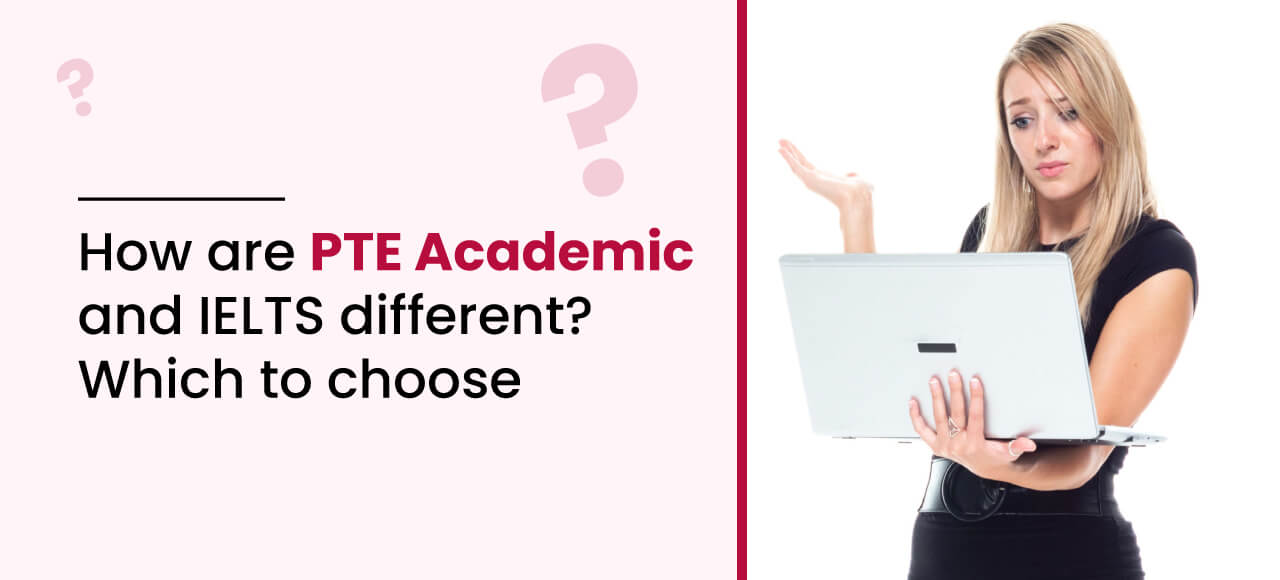
How are PTE Academic and IELTS different? Which to choose?
For anyone looking to study or work abroad, language proficiency tests are often a necessary requirement. Two of the most popular tests used to assess English proficiency are the Pearson Test of English Academic (PTE Academic) and the International English Language Testing System (IELTS) exams.
However, deciding which one to take can be challenging, especially if you’re not familiar with the differences between the two. In this article, we’ll answer your questions revolving around the topic of how are PTE Academic and IELTS different, examine their pros and cons, and help you decide which test to take.
Overview of PTE Academic
The PTE Academic test is a computer-based exam designed to assess English language proficiency for non-native speakers. It measures the four language skills: reading, writing, speaking and listening.
The test explores into three main parts: speaking and writing, reading, and listening. The duration of the PTE test is just 3 hours.
Furthermore, you can prepare for the PTE exam at home with numerous materials available on the internet.
Overview of IELTS
On the other hand, the IELTS test is an exam designed to assess English proficiency for non-native speakers. It measures the four language skills: reading, writing, speaking and listening. There are two types of IELTS exams: Academic and General Training.
Exploring even further, the Academic version is for candidates seeking admission to higher education institutions, while the General Training version is for candidates who want to work or migrate to an English-speaking country.
For this test, there are four parts: reading, writing, speaking, and listening. The test duration of IELTS is similar to the PTE exam i.e 3 hours.
🔔Learn more: Can you take PTE Academic online? All you need to know about it
Comparison of PTE Academic and IELTS
PTE Academic and IELTS are both very popular English language proficiency tests, however, they have significant differences in terms of test format, scoring, and availability.
We can realize that PTE Academic is a computer-based test that delivers the test questions via computer and records the speaking responses of the test taker.
On the other hand, IELTS offers both physical and computer-based tests now, giving test-takers more options to choose from.
Another significant difference between the two tests is the scoring system. PTE Academic uses an automated scoring system that is based on a set of predefined rules and algorithms, while IELTS uses a human examiner to evaluate the test taker’s language skills.
Additionally, PTE Academic typically provides test results within five business days, whereas IELTS results are typically available within 13 calendar days. Also, the test score for PTE Academic is on a scale of 10 to 90, while the test score for IELTS is on a scale of 0 to 9.
These differences mean that the score ranges for each test are different, and you’ll need to achieve a different minimum score to pass each test.
The test structure of PTE and IELTS
The PTE test is entirely computer-based and consists of four sections: Speaking and Writing, Reading, Listening, and an optional 10-minute break. The IELTS test, on the other hand, is available in two formats: Academic and General Training. Both formats consist of four sections: Listening, Reading, Writing, and Speaking, and are conducted either on paper or a computer.
Moreover, the IELTS Speaking test is a face-to-face interview with an examiner, while the PTE Speaking test is a recorded computer-based test.
Not to mention, the structure and format of both tests assess the candidate’s proficiency in the English language and their ability to use it in an academic or practical setting.
Advantages and Disadvantages of PTE
The advantages of PTE Academic include its computer-based format, quick results, and dedicated pronunciation section. Because the PTE Academic test is AI and it offers several advantages over paper tests.
For example, PTE conducts these tests using an Artificial intelligence interface, and you’ll receive your test results within five business days, which is faster than most other language proficiency tests. Additionally, the dedicated pronunciation section is a valuable feature that can help you improve your speaking skills and achieve a higher score on the test.
On the other hand, the disadvantages of PTE Academic include its relatively new format, which may not be familiar to some test-takers, and the lack of face-to-face interaction during the speaking section.
You’ll interact with a computer program during the speaking section, which may not be as natural or comfortable as speaking with a live person. The test is relatively new, there may be fewer resources available to help you prepare for the exam compared to other well-established tests like IELTS.
Advantages and Disadvantages of PTE
The advantages of IELTS include its long-standing reputation, the availability of a paper-based test, and the option to choose between Academic and General Training versions. IELTS has been around for over 30 years and over 10,000 organizations worldwide acknowledge this test, including universities, employers, and immigration authorities.
Additionally, the availability of a paper-based test may be preferable for some test-takers who are more comfortable with a traditional test format. The option to choose between Academic and General Training versions also allows test-takers to select the version that is most relevant to their goals.
However, the disadvantages of IELTS include its lengthy test time, the wait time for results, and the lack of a dedicated pronunciation section. IELTS takes about three hours to complete, which can be a disadvantage for some test-takers who prefer shorter test times.
Also, it may take up to 13 days to receive your test results, which is longer than the five-day wait time for PTE Academic results. Finally, the lack of a dedicated pronunciation section means that your speaking skills will be assessed in the same section as your ability to answer other types of questions, which may not provide as much insight into your pronunciation skills.
IELTS vs PTE Academic: Differences
Following is a clear tabulated format illustrating the difference between these tests.
| S.N. | IELTS | PTE |
| 1. | It can be both a paper or a computer-based test. | It is completely a computer-based test. |
| 2. | Test time is 2hrs and 55 minutes in duration of two days. | Test time is 3 hours and completes in a single day. |
| 3. | Interview with the test taker for the speaking test | AI( Artificial Intelligence) evaluates your score. |
| 4. | 10000+ universities accept IELTS | 6000+ universities accept PTE. |
| 5. | It is more complex than PTE. | It is easier compared to IELTS. |
Ease of scoring
When it comes to the ease of scoring, PTE and IELTS differ in their approach. PTE uses automated scoring systems, which means that computer algorithms are responsible for grading the test, with no human intervention. This makes the scoring process more objective, consistent, and faster than IELTS, as the results are available within five business days.
However, the automated system may not always capture the nuances of the candidate’s response, such as tone or context, which can sometimes lead to inaccurate scoring. In contrast, IELTS uses human examiners to grade the tests, which can lead to more subjective and potentially inconsistent results.
Nevertheless, the examiners evaluate the candidate’s performance according to established criteria, which reduces the risk of bias or errors. Overall, while PTE offers a faster and more standardized scoring process, IELTS ensures a more nuanced and reliable assessment of the candidate’s English proficiency.
Validity and Reliability of PTE and IELTS
Alright, let’s talk about the validity and reliability of PTE and IELTS tests.
These tests go through extensive research and validation, and educational institutions and immigration authorities widely accept their scores. This means that if you take either test and achieve a high score, you can be confident that your language skills meet the requirements for admission or immigration purposes.
Both tests have demonstrated consistent and accurate measures of language proficiency in terms of reliability, exhibiting high internal consistency and inter-rater reliability.
Of course, like any standardized test, there is always some degree of variability in the results, but overall, both PTE and IELTS are reliable measures of English proficiency.
So, if you’re preparing for one of these tests, you can trust that your score will accurately reflect your language abilities.
✅ Also check out: PTE Exam Preparation at Home
Clearing the Confusion
If you’re still confused about which test to take, here are a few questions to consider:
- Which test is more widely accepted by the institutions or organizations you’re applying to?
- Which test format do you prefer, computer-based or paper-based?
- Are you more comfortable with a test that includes a dedicated pronunciation section, or do you prefer a more traditional test format?
Based on your answers to these questions, you should be able to determine which test is the best fit for you.
Conclusion
Choosing between PTE Academic and IELTS can be challenging, but by understanding the differences between the two tests and considering your individual needs and preferences, you can make an informed decision.
Both tests have their advantages and disadvantages, and it’s up to you to decide which one is the best fit for your goals.
To help you prepare for the test you choose, choose an e-learning platform like CCLHUB. Assisted with expert guidance, CCLHUB provides PTE study materials, practice tests, and a range of resources to help you succeed in PTE.
FAQ
Q: What’s the difference between PTE and IELTS?
PTE uses automated scoring and is a computer-based test, while IELTS can be scored by human examiners and can be taken on paper or computer. Additionally, the speaking section of the tests differs in format, with PTE using a recorded computer-based test and IELTS using a face-to-face interview with an examiner.
Q: How long are the test scores valid?
Both PTE and IELTS scores are generally valid for two years from the test date.
Q: Can I take the tests multiple times?
Yes, you can take both tests multiple times, but there is a waiting period between attempts. For PTE, you must wait at least 5 days before retaking the test, while for IELTS, the waiting period is 2 to 3 months.
Q: How much do the tests cost?
The cost of the tests varies by country and location, but in general, PTE is slightly more expensive than IELTS. In the United States, for example, the cost of PTE is around $200, while IELTS costs around $245. However, it’s important to check the fees for your specific location, as they may vary.



